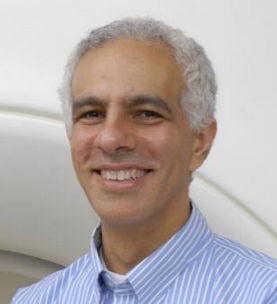Michael Zeineh

Michael Zeineh, MD, PhD, is an Assistant Professor of Radiology at the Stanford University Medical Center. He is board certified in Neuroradiology and Diagnostic Radiology. His medical interests are Neuroradiology, Clinical Functional MRI, and Clinical Diffusion Tensor Imaging.[1] He has performed research in advanced MR imaging of Alzheimer's Disease, Epilepsy, Multiple Sclerosis, and Parkinson's Disease.[2] He worked with Dr. Jose Montoya to investigate brain abnormalities in Chronic Fatigue Syndrome.[3]
Education[edit | edit source]
- 1995, B.S. in Biology from Caltech
- 2003, MD/PhD from UCLA
- 2004, Internship at UCLA School of Medicine
- 2008, Residency in Radiology at Stanford University
- 2009, Fellowship in Neuroradiology at Stanford University
Awards[edit | edit source]
- 2015 Doris Duke Foundation Clinical Scientist Development Award - received a three-year grant of $486,000 to support his transition to an independent clinical research career.[4]
Committees and boards[edit | edit source]
ME/CFS Common Data Element (CDE) Project[edit | edit source]
Dr Zeineh serves on the Baseline/Covariate Working Group and the Neurologic/Cognitive/CNS Imaging Working Group of the Myalgic Encephalomyelitis/Chronic Fatigue Syndrome Common Data Element (CDE) Project sponsored by the National Institute of Neurological Disorders and Stroke and the Centers for Disease Control and Prevention.[5]
Notable studies for ME/CFS[edit | edit source]
- 2015, Right Arcuate Fasciculus Abnormality in Chronic Fatigue Syndrome[3] (Full Text)
Talks and interviews[edit | edit source]
Media coverage[edit | edit source]
- 2014, Brains of People With Chronic Fatigue Syndrome Offer Clues About Disorder - The New York Times - Well section on November 24, 2014.[6]
- 2014, Findings of brain anomalies may shed light on chronic fatigue, SFGate, online version, by Erin Allday, Wednesday, October 29, 2014[7]
- 2014, Not just lazy: Chronic fatigue is real, new brain scans show, 29 October 2014, Today Health and Wellness
Online presence[edit | edit source]
See also[edit | edit source]
Learn more[edit | edit source]
References[edit | edit source]
- ↑ https://med.stanford.edu/profiles/michael-zeineh
- ↑ https://www.linkedin.com/in/michael-zeineh-6a8b0830
- ↑ 3.0 3.1 Zeineh, Michael M.; Kang, James; Atlas, Scott W.; Raman, Mira M.; Reiss, Allan L.; Norris, Jane L.; Valencia, Ian; Montoya, Jose G. (2015). "Right Arcuate Fasciculus Abnormality in Chronic Fatigue Syndrome". Radiology. 274 (2): 517–526. doi:10.1148/radiol.14141079. ISSN 0033-8419.
- ↑ http://www.ddcf.org/grants/Grant-Recipients/2015-csda-grantees/
- ↑ "Complete Myalgic Encephalomyelitis/Chronic Fatigue Syndrome CDE Roster". NIH. Retrieved October 11, 2019.
- ↑ Brains of People With Chronic Fatigue Syndrome Offer Clues About Disorder - The New York Times - Well
- ↑ Allday, E. (2014, October 29). Findings of brain anomalies may shed light on chronic fatigue. SFGATE. Online version.
- ↑ https://www.rt.com/news/200551-chronic-fatigue-disease-study/

